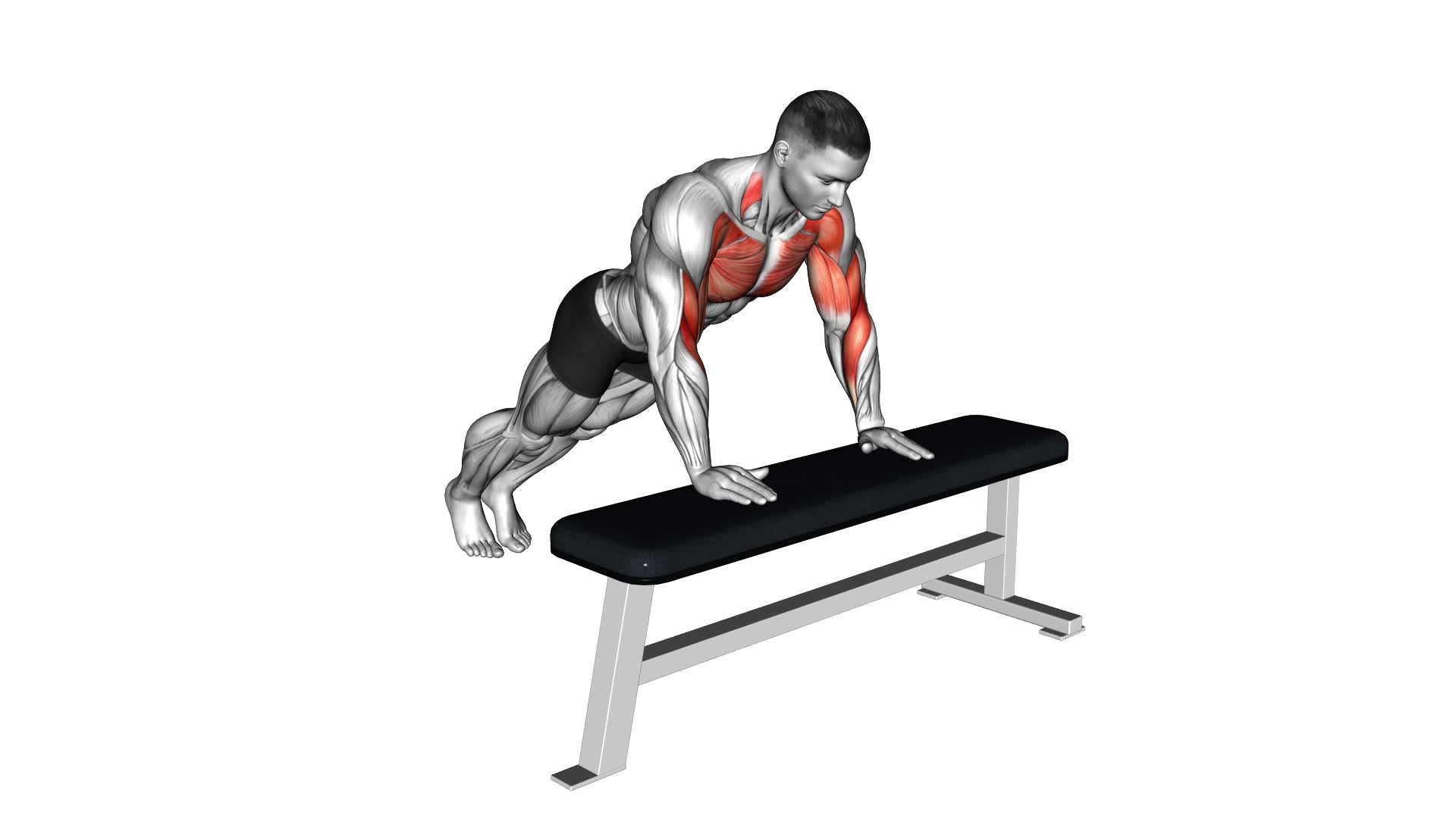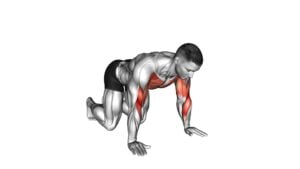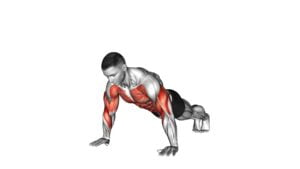Incline Shoulder Tap – Video Exercise Guide & Tips

Looking to strengthen your shoulders and core? Look no further than the incline shoulder tap!
Watch This Exercise Video
In this video exercise guide, we'll show you the proper form and technique for this challenging move.
With variations and progressions to suit all fitness levels, you can customize your workout to meet your goals.
Avoid common mistakes and get tips for a successful incline shoulder tap workout.
Get ready to feel the burn and achieve a stronger upper body.
Let's get started!
Key Takeaways
- Engages multiple muscle groups simultaneously
- Targets shoulders, core, and upper body
- Increases upper body strength
- Engages core muscles and improves stability and balance
Benefits of Incline Shoulder Tap
One major benefit of incline shoulder taps is that they engage multiple muscle groups simultaneously. This exercise targets your shoulders, core, and upper body, making it an effective and efficient workout option. The incline position adds an extra challenge to the exercise, increasing the intensity and helping to build strength and stability in your upper body.
Incline shoulder taps also improve your balance and coordination. By balancing on your hands and toes while performing the taps, you're forced to engage your core muscles to maintain stability. This not only strengthens your core, but also enhances your overall balance and body control.
To execute incline shoulder taps effectively, start by positioning yourself in a high plank position with your feet elevated on an incline bench or step. Keep your body in a straight line from head to toe, engage your core, and maintain a neutral spine. Alternate tapping your left and right shoulders with your opposite hand, while keeping your hips stable and minimizing any rotation in your body.
Mastering the proper form and technique of incline shoulder taps is crucial to maximize the benefits and avoid injury. So, let's dive into the next section, which will provide you with detailed instructions for performing this exercise correctly.
Proper Form and Technique
To perform incline shoulder taps with proper form and technique, follow these steps:
- Position yourself in a high plank position with your feet elevated on an incline bench or step.
- Start by placing your hands shoulder-width apart on the ground and extend your legs behind you, keeping your body in a straight line.
- Engage your core muscles by drawing your belly button towards your spine and maintaining a neutral spine position.
- Keep your shoulders stable and avoid any excessive movement or rotation as you tap one hand to the opposite shoulder.
- Maintain a controlled and steady pace throughout the exercise, focusing on the movement and maintaining proper form.
- Remember to breathe steadily throughout the exercise to ensure proper oxygenation of your muscles.
Shoulder stability is crucial for this exercise, as it helps to prevent any unwanted shoulder movement and maintain proper alignment. Engaging your core muscles throughout the exercise is also essential for stability and to protect your lower back.
Variations and Progressions
As you progress with the incline shoulder tap exercise, you can incorporate variations to challenge your shoulder stability and core strength even further. One way to add variety is by using different equipment. Instead of using an incline bench, you can try using a stability ball or a Bosu ball to increase the instability and engage more muscles. Another option is to use resistance bands or dumbbells to add resistance to the exercise.
Modifications and regressions can also be helpful in adjusting the difficulty level of the exercise. If the incline shoulder tap is too challenging, you can start by performing the exercise on an elevated surface such as a step or a sturdy box. This will decrease the angle and make it easier to maintain your balance. Additionally, you can modify the exercise by performing it on your knees instead of your toes, which will reduce the amount of weight on your shoulders.
By incorporating these variations, modifications, and regressions, you can continue to challenge yourself and make progress in your shoulder stability and core strength.
Now, let's move on to the next section and discuss common mistakes to avoid in order to ensure proper form and maximize the benefits of the incline shoulder tap exercise.
Common Mistakes to Avoid
To maximize the benefits of the incline shoulder tap exercise, avoid these common mistakes:
- Rounding your back: Maintain a straight line from your head to your heels throughout the exercise. Rounding your back can put unnecessary strain on your spine and decrease the effectiveness of the exercise.
- Lifting your hips: Keep your hips level with your shoulders and avoid lifting them up or sagging them down. Lifting your hips reduces the engagement of your core muscles and shifts the focus away from your shoulders.
- Rushing the movement: Perform the shoulder taps in a slow and controlled manner. Rushing through the exercise can lead to poor form and decrease the effectiveness of the movement. Take your time and focus on proper execution to get the most out of the exercise.
By avoiding these common mistakes, you can ensure that you're performing the incline shoulder tap exercise correctly and maximizing its benefits. Remember to maintain proper form, engage your core, and perform the movement in a controlled manner.
Incorporate this exercise into your routine to strengthen your shoulders, core, and upper body.
Tips for a Successful Incline Shoulder Tap Workout
To ensure a successful incline shoulder tap workout, focus on maintaining proper form and engaging your core throughout the exercise. This will help you maximize the benefits and reduce the risk of injury.
Here are some tips to help you get the most out of your workout.
First, make sure that the incline bench is set at an appropriate angle. Too steep of an incline can put unnecessary strain on your shoulders, while too shallow of an incline may not engage your core effectively. Find a comfortable angle that allows you to perform the exercise with good form.
Next, consider modifications to the incline shoulder tap if needed. If you find it difficult to maintain stability, try performing the exercise on a flat surface instead. This can help you build shoulder stability before progressing to the incline version.
Additionally, incorporating shoulder stability exercises into your routine can further enhance the effectiveness of the incline shoulder tap. Exercises such as shoulder external rotations and scapular retractions can help strengthen the muscles around the shoulder joint, improving stability and reducing the risk of injury.
Remember to start with a weight or resistance level that challenges you without compromising your form. As you become more comfortable and proficient with the exercise, gradually increase the intensity to continue progressing and seeing results.
Frequently Asked Questions
How Many Calories Can Be Burned During a Workout of Incline Shoulder Taps?
During a workout of incline shoulder taps, you can burn a significant number of calories. This exercise engages your core muscles, leading to increased calorie expenditure.
In addition to burning calories, incline shoulder taps also offer benefits for core strength. By incorporating this exercise into your routine, you can't only achieve your calorie-burning goals but also strengthen your core muscles for improved stability and posture.
Can Incline Shoulder Taps Help Improve Overall Core Strength?
Incline shoulder taps are a great exercise for improving core strength and stability. By performing this exercise, you can target your abdominal muscles and obliques, which are essential for maintaining proper posture and balance.
The incline position adds an extra challenge, forcing your core muscles to work harder to stabilize your body.
Are There Any Modifications or Alternatives for Those With Wrist Pain or Injuries?
If you're experiencing wrist pain or have a wrist injury, there are some wrist-friendly modifications and alternatives for the incline shoulder tap exercise.
It's important to protect your wrists while still working your core. Instead of placing your hands on the incline surface, you can use dumbbells or push-up handles to elevate your hands.
This will reduce the strain on your wrists and allow you to perform the exercise without discomfort or further injury.
How Often Should Incline Shoulder Taps Be Incorporated Into a Workout Routine for Optimal Results?
For optimal results, it's important to consider the frequency and progression of incorporating incline shoulder taps into your workout routine.
By regularly including this exercise, you can build strength and stability in your shoulders.
Start by adding it to your routine two to three times a week, and gradually increase the frequency as you become more comfortable and stronger.
Remember to listen to your body and give yourself enough time to recover between sessions.
Can Incline Shoulder Taps Be Effective for Individuals With Limited Upper Body Strength?
Incline shoulder taps can be effective for individuals with limited upper body strength. The exercise helps strengthen the shoulders, core, and arms.
If you have limited strength, you can modify the exercise by performing it on a lower incline or starting with a shorter duration.
Additionally, if you have shoulder injuries, you can modify the exercise by performing it with your knees on the ground instead of in the inclined position.
Always consult with a professional before modifying any exercise.
Conclusion
Incline shoulder taps are an effective exercise for targeting the shoulders, core, and upper body strength. By maintaining proper form and technique, you can maximize the benefits of this exercise.
Additionally, varying the difficulty level and avoiding common mistakes will help you progress and achieve better results. Remember to incorporate these tips into your incline shoulder tap workout for a successful and challenging session.

Author
Years ago, the spark of my life’s passion ignited in my mind the moment I stepped into the local gym for the first time. The inaugural bead of perspiration, the initial endeavor, the very first surge of endorphins, and a sense of pride that washed over me post-workout marked the beginning of my deep-seated interest in strength sports, fitness, and sports nutrition. This very curiosity blossomed rapidly into a profound fascination, propelling me to earn a Master’s degree in Physical Education from the Academy of Physical Education in Krakow, followed by a Sports Manager diploma from the Jagiellonian University. My journey of growth led me to gain more specialized qualifications, such as being a certified personal trainer with a focus on sports dietetics, a lifeguard, and an instructor for wellness and corrective gymnastics. Theoretical knowledge paired seamlessly with practical experience, reinforcing my belief that the transformation of individuals under my guidance was also a reflection of my personal growth. This belief holds true even today. Each day, I strive to push the boundaries and explore new realms. These realms gently elevate me to greater heights. The unique combination of passion for my field and the continuous quest for growth fuels my drive to break new ground.







